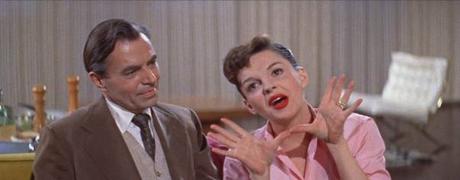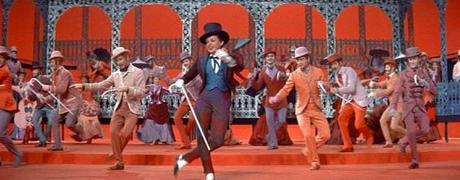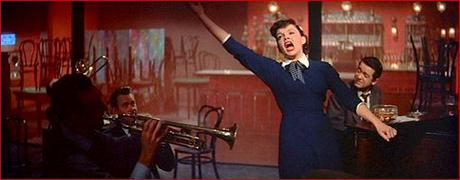 James Mason & Judy Garland in A Star is Born (1954)
James Mason & Judy Garland in A Star is Born (1954)In reading critic and author David Thomson’s The Big Screen, a book about the history of motion pictures, I came upon a section devoted to movie musicals — specifically, the 1954 musical version of A Star is Born with Judy Garland and James Mason, produced by Sid Luft (Judy’s husband at the time), directed by George Cukor for Warner Bros., and written by Moss Hart.
The 1937 version, produced by David O. Selznick, was conceived by Alan Campbell, Robert Carson, Dorothy Parker, and William Wellman after Adela Rogers St. John’s story, “What Price Hollywood?,” the 1934 film of which Cukor also directed. Thomson points out a connection I had never noticed before now: that the wistful music for both “The Man That Got Away” from A Star is Born and the nostalgic song, “Over the Rainbow” from The Wizard of Oz (1939), were composed by the same person, Harold Arlen — a coincidence perhaps? Hmm … perhaps. And both numbers in turn were performed by the same singer, Judy Garland, at opposite ends of her fame and fortune.
If it can be said of any artist, it most assuredly can be exemplified in the work of the former Frances Ethel Gumm: that she wore her pain on her sleeve. In Judy’s world, it would be considered a badge of honor (or dishonor, depending on your point of view), to be shared with anyone and everyone you had come into contact with.
When we’re young and naïve, the mere thought of experiencing pain and hurt are anathema to one’s being. It’s so traumatic a sensation that you would want to flee the room — and the person — where that pain was present. As we grow older and, we must admit, hopefully wiser, we long to be near it; to grasp it, to hold it, to stroke it, much as a moth is helplessly drawn to the flame. We know we may be burned by our proximity to the one whose pain and anguish erupts from every fiber of her soul. But that’s exactly how we should experience Judy Garland’s art at this, the pinnacle of her career. Her pain was our pain — and it’s inescapable.

This film, made when she was only 32 (but looking years older), is Judy at her tortured peak, her “swan song” to her fans; an insider’s fisheye glimpse of a complicated life lived in full view of the paying public. By now, most viewers will be familiar with the plot of talented band singer Esther Blodgett (Judy), rechristened Vicki Lester, whose career rises in direct proportion to her alcoholic actor-husband Norman Maine’s faltering one. To spare his wife from tumbling right along with him, Norman (Mason) decides to end his life by drowning his troubles at sea. That tragic ending may remind audiences of Joan Crawford’s sad demise in Humoresque (1946).
Both Garland and Mason shine in this fabulous Technicolor widescreen CinemaScope spectacular, with Judy dancing and singing her way to the top, and providing equal parts vulnerability and humor to overcome her many backstage issues (i.e., her dependency on drugs and alcohol, her weight problems, and her illnesses, both real and perceived). Judy was an expected shoe-in for an Academy Award that year as Best Actress, but she was denied the honor in favor of Grace Kelly’s performance in The Country Girl. Coincidentally, that film’s story line was also about an alcoholic husband (Bing Crosby) whose long-suffering wife (Kelly) stands by her man to the end (a happy ending in this case).
Besides the aforementioned “The Man That Got Away,” which summarizes the story textually and contextually, there is the 18-minute “Born in a Trunk” sequence to admire, choreographed by Richard Barstow to the music and words of Roger Edens and Leonard Gershe. Other songs include Harold Arlen and Ira Gershwin’s “Gotta Have Me Go With You,” “Here’s What I’m Here For,” “It’s a New World,” “Someone at Last,” and “Lose That Long Face,” along with a medley of George Gershwin and Rodgers & Hart tunes. The other cast members include Charles Bickford, Jack Carson, Tommy Noonan, and Amanda Blake.
Trimmed of approximately 37 minutes after its successful release, A Star is Born has been painstakingly reconstructed to 176 minutes (but not the test-cut time of 196 minutes or the premiere running time of 182 minutes) for the DVD/Blu-ray Disc editions, with scenes and numbers restored using photographs, pan and scan footage, and snippets of outtakes, making it a not to be missed, home-viewing experience.
Sadly, once you’ve seen the end product, you may never want to view it again. Considering what Judy went through in the final months of her life in London, England (epitomized in Peter Quilter’s theatrical play, Judy Garland – The End of the Rainbow) in eerie imitation of the film’s premise, there’s just too much pain attached. Indeed, she paid the ultimate price for Hollywood stardom: Judy passed away on June 22, 1969, at the age of 47.

The film was remade for a third time by Warner Bros. in 1977, as a vehicle for Barbra Streisand and Kris Kristofferson, in more of a pop-rock hippie milieu; and indirectly by Twentieth-Century Fox in 1979 as The Rose, with Bette Midler and Alan Bates, where the star herself goes off the deep end. The latter picture was actually based on the self-destructive life of Janis Joplin who died of an overdose of heroin laced with alcohol. Joplin was all of 27, twenty years younger than Garland.
Copyright © 2015 by Josmar F. Lopes

